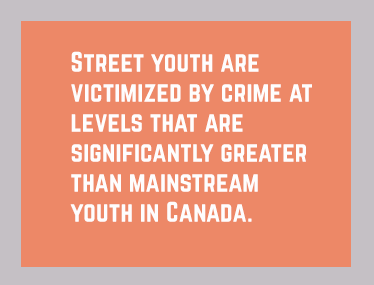Homeless people, especially homeless youth, are often regarded as threats to public safety. In the news it is common to read stories or hear reports that a law abiding member of the public was a victim of a crime committed by an individual of no fixed address. In other words, the assailant was a homeless person. And research does show, compared to the general population, certain types of street crime and illegal drugs use is more common amongst people who are homeless.
 But if we scratch beneath the surface, and review the research in this area more closely, a different picture begins to emerge about the relationship between crime, victimization and homelessness. Studies show that street youth (ages 16-24) are victimized by crime at levels that are significantly greater than mainstream youth in Canada. The results of a recent survey carried out in Toronto, for example, shows the incredibly high rates of criminal victimization amongst this population: over 76% reporting at least one incident in the previous 12 months. This figure is almost three times greater than is the case for the general population. In addition, the frequency of such victimization is also extremely high, with almost three quarters reporting multiple incidents of victimization within the same 1 year period. While such victimization does include such things as minor property crime, it also includes much more serious crime like sexual assault. Close to 40 % of female homeless youth reported to have been sexually assaulted in the past year.
But if we scratch beneath the surface, and review the research in this area more closely, a different picture begins to emerge about the relationship between crime, victimization and homelessness. Studies show that street youth (ages 16-24) are victimized by crime at levels that are significantly greater than mainstream youth in Canada. The results of a recent survey carried out in Toronto, for example, shows the incredibly high rates of criminal victimization amongst this population: over 76% reporting at least one incident in the previous 12 months. This figure is almost three times greater than is the case for the general population. In addition, the frequency of such victimization is also extremely high, with almost three quarters reporting multiple incidents of victimization within the same 1 year period. While such victimization does include such things as minor property crime, it also includes much more serious crime like sexual assault. Close to 40 % of female homeless youth reported to have been sexually assaulted in the past year.
What makes matters worse, is that a very high percentage (23%) report that they do not tell anyone, even friends, when they have been victimized. This is a reflection of the isolation that often comes with being homeless, and the weakness of social networks that young people are able to rely on when in crisis. Sadly, it also an indication that many street youth do not feel that it is worthwhile to report such victimization to the police.
Such apprehension to contact the police is likely related to the strained relations that many homeless people have with law enforcement officials. Research shows that while homeless youth who are involved in activities such as drug dealing report negative encounters with the police, so too do homeless youth who are not involved in illegal activities. For many homeless youth, one of the key outcomes of their encounters with police is that they receive tickets for noncriminal code violations for a broad range of activities. In Ontario much of this ticketing involves infractions related to the Ontario Safe Streets Act. In some cases, they are clearly receiving an inordinate number of them. For this and other reasons and, it oftentimes does not make sense for a homeless person to go to the police to report a crime that has been committed against them, as they feel the police may not believe them or would not take their report seriously.
So if the federal government is sincere in its mandate to protect all crime victims in Canada and provide them with a louder voice in our justice system they would be wise to bring about more public awareness to the issue of criminal victimization experienced by homeless people in Canada today. And if the federal government really wanted to protect homeless people from these unacceptably high levels of victimization, placing more resources into affordable housing would be a good place to start.

